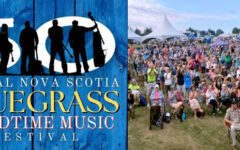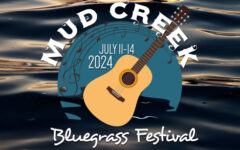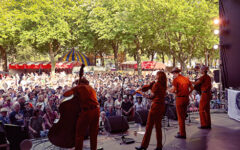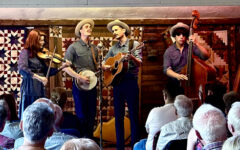
On November 6, 1968, Angelika Torrie was born.
The long-time treasurer of the European Bluegrass Music Association (EBMA), was born and raised in Dornach, near Basel, Switzerland.
She grew up in an environment where classical music was important. At school, music was (and still is) an important element. At the age of 10 Torrie began to take violin lessons and soon joined the school orchestra. Although she admits that she didn’t always enjoy the practicing (who does?), she is very grateful that she was encouraged to learn to play the violin.
Torrie has been a bluegrass music lover since the late 1980s, when she first heard it, and has been actively involved since 1991; as a fiddle player in two Basel-based bands, firstly with Down Yonder and then in the Bluegrass Hoppers.
Later, in 1993, Torrie became involved in the administration and promotion of bluegrass music when she joined some like-minded individuals in setting up the Swiss Bluegrass Music Association. From October 1999 through to September 2004 she was the chair of the board of this organisation.
Torrie became involved in the European Bluegrass Network (EBN) from its very beginnings in Basel in 1995. She was tasked to act as the representative for the Swiss bluegrass community and to type the first two editions of the European Bluegrass Directory.
She is a co-founder of the European Bluegrass Music Association (EBMA) and has been its treasurer as well as the membership administrator, and chairperson until 31st March 2012, which is when chairmanship started to be rotating annually among all EBMA board members.
Torrie started to play bass with a new local band, LICKS, at the moment, and is looking forward to bringing this band out into Europe eventually.
She is an alum of the IBMA’s Leadership Bluegrass class of 2011. Torrie is a single mum with two children, Danilo (11), and Jasmin, (8).
So much for the bald facts; what caused Angelika Torrie to become a fan of the music, to be an active performer and then move on to administrative and promotional roles within the bluegrass music community?
What is it about bluegrass music that attracted you to it?
It’s a music of the heart! Initially I felt most attracted by instrumental virtuosity played in a free way (without sheet music). Singing, and harmony singing certainly, was important too, but I heard the singing rather as part of the instruments than the words. I have to really concentrate if I want to catch the lyrics of a song (other people seem to be the other way round…). I’ve always been most impressed with instrumental virtuosity. Of course, this might be something that may be found in other musical styles, too, but there’s another element that attracted and kept me in the bluegrass music; the easy access to artists and to people who like this music. I haven’t found another cultural activity where people across borders and oceans connect so easily than within the bluegrass scene. In addition, I like to watch the development bluegrass music goes through when it’s played by bands of various European countries. In some cases it seems to pick up the musical heritage of the particular country – sometimes more, sometimes less.
You play the fiddle (violin); is that something that you did before learning about bluegrass music? Tell me about your interest in the instrument.
Starting at a relatively early age, I think I was a pretty good player at 18; I even played solo parts in the school orchestra. I took my instrument with me when I spent one year in Scotland after school (baccalaureate). There, I discovered the Scottish folk dance and music. And ironically it was in a pub called The Fiddlers Arms where I played in a jam session for the first time and picked up Devil’s Dream. It was only a few years after my return to Switzerland that I discovered I actually qualified to play in a bluegrass band (until then I had only heard bluegrass music once on a bad live recording!). I was asked to join a band of a banjo playing friend of mine as their fiddle player in 1991.
You have been pro-active in getting bluegrass aficionados organised to support and promote bluegrass music; what has been your motivation in this regard?
It just happened without me looking for it. In 1993 there was a call for action by the owner at that time of the Swiss Bluegrass mail-order shop Acoustics, Ruedi Happle, for the Swiss bluegrass scene to form a loose group for monthly meetings. Only one year later, on 3rd June 1994, the Swiss Bluegrass Music Association was formed. A strong force behind this formation was Paolo Dettwiler, probably the first second-generation bluegrasser in Switzerland, son of one, if not the, banjo pioneer Ruedi Dettwiler in Switzerland. With a talent for accounting (working as a secretary in an accountants company was enough qualification), I became treasurer. Always working closely with Paolo led to my election as chairperson after Paolo’s resignation in 1999. In parallel, I was asked to help organize tours for American bluegrass bands, which evolved into another activity as a self-employed booking agent.
Paolo – as many will know and remember – was also a driving force in forming the European Bluegrass Network, which became the European Bluegrass Music Association on 4th February 2001. As it worked so well in the Swiss association, I was elected as treasurer with Paolo being the chairperson.
In 2004 I stepped back from the SBMA board only a few weeks before my second child was born.
What progress do you think the Swiss Bluegrass Music Association and the European Bluegrass Music Association have made since their formation?
Both organisations have been able to concentrate the fan base and to offer useful services to musicians and other people active in connection with bluegrass music. And they’ve both become umbrellas for activists and consumers of the music and, it can’t be denied, they have actually raised the image of bluegrass music to the “outside” world and have been instrumental in keeping bluegrass fans and professionals informed on a regular basis through print and electronic media and in supporting bluegrass events. The main focus at the beginning was to connect people, a goal that has been thoroughly achieved by both organisations. Meanwhile the scene is alive and kicking and in particular the Swiss association is an example for other countries’ national organisations. Now both SBMA and EBMA can focus on priorities such as supporting projects to bring youth to bluegrass music, doing research and acknowledging the pioneers in Switzerland/Europe (thus building a base to preserve the history), and to consolidate information services.
In your view, what have been the most significant events in the improved promotion of bluegrass music in Europe?
The initiation of the European World of Bluegrass month and the EWOB Festival in the Netherlands by the European Bluegrass Network in the 1990s and under the umbrella of EBMA from 2001 through 2010 (since 2011 the festival is run independently from EBMA) has probably developed to be the most significant event in Europe. More and more concerts happening in the month of May as the worldwide month of bluegrass have created a rising awareness of what the music is and the international attention and recognition. The creation of awards from the 2nd EWOB Festival onwards was another achievement, which brought publicity to bands and to the festival itself.
Although a split off from the organizing group in the Netherlands in 2001 caused irritation, this movement too has led into a recognized event with the Bluegrass Festival in La Roche-sur-Foron in France organised on a highly professional level with lots of publicity over four days. This festival now also has a competition, though on a different system than EWOB, with a highly qualified on-site jury of 10 or more people from across Europe.
You took on the role of Chairperson of the EBMA in 2009, how has the organization developed since then and in what ways do you hope it will develop in the future?
The priorities of EBMA are to intensify the networking across borders to enable exchange of know-how in the various fields, to further youth in bluegrass music in Europe, and to continue providing information on an international level. Also, I think it’s important in some cases to create an awareness for bluegrass music being a genre in its own rights, which doesn’t necessarily reflect a certain lifestyle – bluegrass music is a link from person to person, it connects people from heart to heart.
However, as our organisation depends on and exists through voluntary work, we have to be realistic in what can be achieved. Many organisations like ours feel the lack of manpower these days and a lot of work is done by only a handful of people – for free! Therefore, it also has to be a priority to find new people enthusiastic enough to join us in our endeavours, as a task group or even board member. After all, it definitely is a rewarding work. I personally have learned a lot simply by doing it. And meeting and working with people who share the love for our music – my board colleagues, the members and fans, and not to forget the musicians, who bring it to us! – has been enriching my life for the past 20 years and I don’t want to miss one minute of it. Nevertheless, at our board meeting exactly one year ago, we decided to reorganise a bit and put chairmanship onto a rotating system. Therefore, since 1st April of this year, Petr Brandejs from the Czech Republic, is our chair, and after the 5th edition of the European Bluegrass Summit in March next year, it will be another member of the board and so on. This way the workload is more evenly distributed and not focusing on one representative only.
Richard Hawkins reminded me that you took over the role of Editor of the German Bluegrass print magazine Bluegrass Bühne in December 2009; how did that come about?
At that time, three publications were printed in one magazine. All three editors (Rienk Janssen of Strictly Country, Eberhard Finke of Bluegrass Buehne and Paolo Dettwiler of Bluegrass Europe) had decided to retire after the Feb/Mar 2011 issue. Then Eberhard felt he couldn’t face another year and announced his retirement by end of 2009 in March of that year. Being close to the magazine through EBMA and Bluegrass Europe (and German being my mother tongue) I felt that the gap from December 2009 – February 2011 wanted to be filled. With five years editing experience from the Swiss SBMA newsletter I approached Eberhard in May how he’d feel about my taking over this responsibility. Both Eberhard and his wife, Monika, reacted very positively to the idea, which was then made public in fall. Luckily, the readers liked the change, and by the time Bluegrass Europe became independent and Strictly Country ceased, a German Bluegrass Music Association had been formed (in 2010) and took over responsibility for the German magazine. Thus I was free to take over editorship of Bluegrass Europe in February 2011 from Paolo Dettwiler.
Since you took over the editorship of Bluegrass Europe, what are your plans for the magazine in the immediate future?
It had been a topic at the European Bluegrass Summit in 2010, and in the board meetings for a long time, if we needed a magazine, and if yes, it was necessary to have it in print. But eventually everybody agreed that our association (EBMA) needed a tangible asset to offer to members. Thus the magazine was revamped and extended to a 40 page magazine which is still gaining recognition worldwide. With some parts in colour, numerous articles by great writers from both Europe and the US, we think it reflects a part of bluegrass music that is not covered by existing bluegrass publications and we’ve gained many subscribers even in the US.
On a more general note, how do you see the publishing of European bluegrass magazines developing?
A bluegrass magazine based within a bluegrass association fulfills a purpose by informing the membership of local, national and international bluegrass-relevant developments. So as long as there is a committed editor (or even better an editorial team), there is no doubt a European magazine in printed form from the EBMA will be appreciated for many years to come.
Angelika added ……
EBMA’s mission statement is “Working together to support Bluegrass Music across borders.”
So, it is one of my hopes and wishes that EBMA can continue to make links between the bluegrass oriented organisations, festivals, bands, venues and audiences across Europe, to support both US and European bands in touring Europe and to build an even stronger mutual feeling of togetherness. However, with the lack of new people dedicating their time to support us, I’m afraid that eventually the active players will get tired of this kind of Sisyphus -work. This might be the time, an organisation like ours is not needed any longer because by then, the people know where to refer to for information. Hopefully, that is. Until then, we try to share information on our website (www.ebma.org), blog and on Facebook – and of course with our magazine. See you there!
This piece is an adaptation and update of a profile written for Bluegrass Europe magazine, # 75, published August/September 2010.








